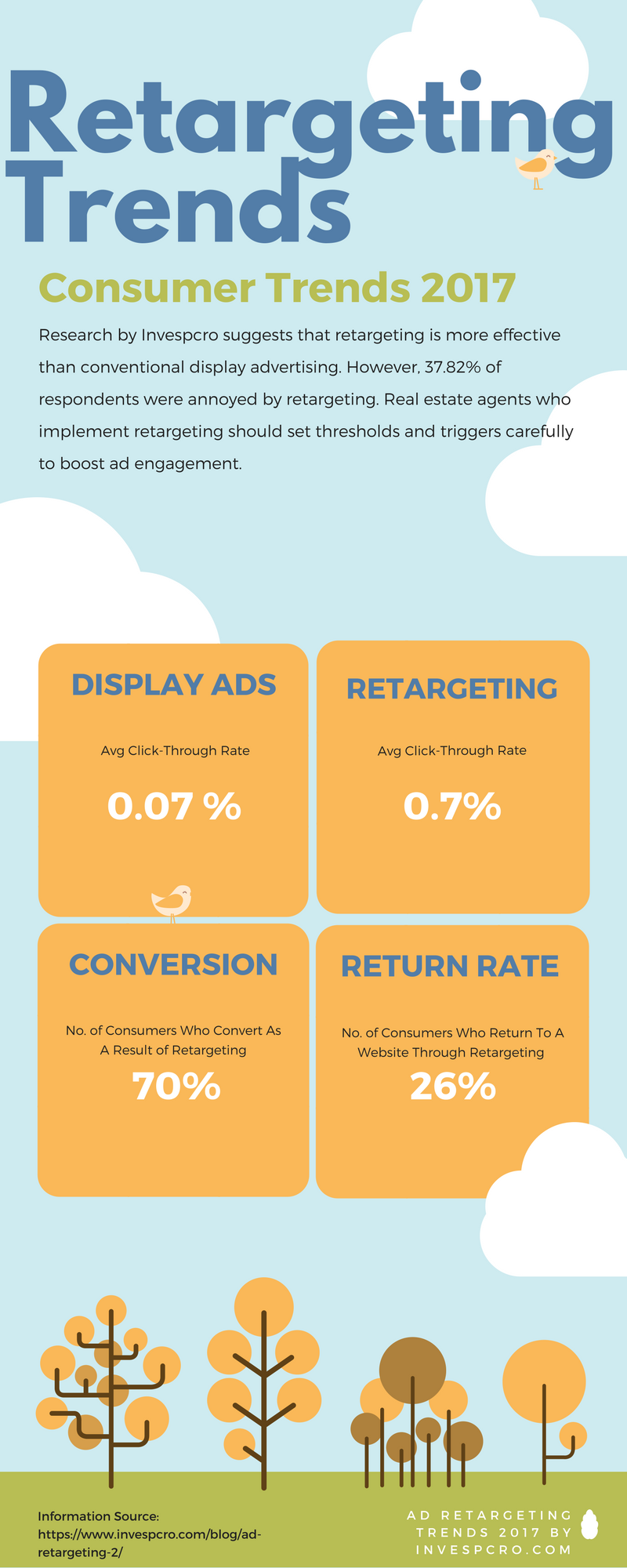You may have recently heard the terms ‘tag marketing’, ‘remarketing’ or ‘retargeting’. If so, and you’re a real estate agent, read on!
Digital marketing agencies are now offering retargeting campaigns for businesses in every industry. Some promise as much as a 50% increase in leads and sales.
Is retargeting really that effective at lead generation?
It’s always a good idea to investigate any new trend before jumping on the bandwagon. If you’ve got questions that need answers, you’ve come to the right place.
In this article, we’ll explain what retargeting is, how it works and the benefits for real estate agents.
What Is Retargeting?
Retargeting is a sophisticated, way of increasing brand exposure with customers who have already visited your website. Using automated technology and simple Javascript coding, retargeting tracks a visitor after they leave your site. It then serves targeted ads to your visitor relevant to their behavior on your website.
Here are some interesting facts from the marketing pros at Invespcro:
- Retargeted customers are 3x more likely to click your ad than cold prospects
- Remarketing can boost ad engagement by as much as 400%
- Average conversion rates for businesses using tag marketing is 55%
- Prospects engaged through remarketing are 70% more likely to convert

These statistics are based on recent figures for 2017. The report also indicates consumer response ranges from very concerned to unconcerned.
Understandably, some buyers and sellers might feel uncomfortable knowing you’re following them after they briefly visited your website.
But If you understand how remarketing works, you can customize your campaign to be more effective, and far less annoying.
Let’s delve into how it works specifically.
How Does Retargeting Work?
How Retargeting Works
A javascript code called a pixel is embedded into specific pages of your site that are of high interest to visitors. The pixel functions like a tracker and can be inserted into the user’s browser upon visiting your site. As they surf other sites, the pixel serves the visitor follow-up ads relevant to the user’s behavior on your site.
Suppose a user visits your website and reviews a number of two-story, semi-detached homes listed between $600K – $800K. The user leaves your site after several minutes and visits another website to read local news. Ads from your site are then displayed on the news site with further listings or information about semi-detached homes you’re listing.
I know. Pretty cool, right? And a little Orwellian. But highly effective.
That being said, there are 2 basic methods for implementing a retargeting campaign:
Method 1: List-based
List-based campaigns require you to upload a pre-existing list of contacts from your CRM or email. The retargeting platform (i.e. Facebook, Twitter) then identifies all of the matching users and displays your ads directly to them. Only members of the site you are connected to will see your ads.
Method 2: Pixel-based
The second method utilizes a tracking pixel. As the name suggests, it’s a bite-sized pixel or image embedded into the pages of your website. It’s utterly unobservable to visitors. Pixels can also be inserted into banner ads, emails, or any other content that you want to track.
Either method is highly effective at boosting your brand exposure.
Now, we’ll take a look at how this exposure benefits agents and brokers.
How Can Retargeting Help Real Estate Professionals?
Repeated exposure to your message is critical to building recognition and share-of-thought with consumers. Brand awareness, nurtured over time, leads to higher conversion.
As consumers become more familiar with your brand, their trust in you grows as well. This is why global brands invest millions in brand awareness campaigns.
Retargeting not only boosts your exposure but also provides relevant brand exposure. Visitors who leave your site can be targeted with ads or messages that are connected to their search behavior.
With a retargeting campaign in place, your ad click-through conversion rate will improve significantly.

Retargeting can help bring prospects back to you!
How Do I Implement A Retargeting Campaign?
There are 2 ways real estate agents can implement a retargeting campaign:
- Social Media Platforms which provide remarketing tools and campaign management
- Third-party services that offer DIY web-based tools and managed campaigns
Social Media Platforms
Many social media giants offer retargeting campaigns for anyone, including real estate professionals. LinkedIn, Facebook, Twitter are all great places to start your exploration.
- Google AdWords Remarketing
- Create A Facebook Pixel
- LinkedIn Website Retargeting
- Twitter Tailored Audiences
5 Third-party Retargeting Services
- Adroll is great for solo agents or teams
- SiteScout offers self-serve remarketing, great for solo agents.
- ExactDrive, based in Milwaukee, is an internet marketing service.
- If you’re a marketer for a real estate agency, consider Criteo.
- ReTargeter offers DIY retargeting and managed campaigns for larger agencies.
This list above is by no means exhaustive, but these third-party retargeting services are among the top brands.
Once you choose one that meets your needs, you can move to the next step of implementation.
How To Implement A Retargeting Campaign

Whether you decide to use social media or a third-party service, it’s best to plan your campaign carefully.
Your goals should be simple:
- higher click-through rate
- more engagement on social media through ads
- improved conversion of click-throughs to your site
Retargeting will make it easier to convert homeowners and buyers after they leave your website but don’t be overzealous!
That being said, here are some tips to help you plan your campaign:
6 Tips For Executing Your Retargeting Campaign
#1) Segment your database.
If your CRM or email database is properly segmented, you can upload lists of prospects based on specific criteria. This can be used to display more relevant ads that reflect each prospect’s unique interests.
Place different retargeting pixels on the targeted pages of your site. Then, design creative marketing messages that can be displayed based on the unique content you offer. This way, you can design messages customized to each stage of the buyer cycle.
For example, potential buyers who view the specs on a home can be sent targeted ads regarding mortgaging options or an offer for a buyer consultation. Visitors who read your blog can be followed up with an offer to subscribe to your newsletter.
#2) Geographic, Demographic, Contextual Targeting.
Segmenting your database by neighborhood, age, property type, associations and other criteria can make your retargeting campaign more strategic and cost-effective. You’ll also be able to measure your ROI more precisely by targeting ads to specific market segments.
#3) Set Display Frequency caps.
Overexposure to your display ads is certain to annoy your prospects rather than convert them. Setting a cap on the frequency of your display ad at 15 – 20 per month is considered reasonable.
Be sure to set a cap on the frequency of visits before triggering a cookie as well. A user who visits your website 3x in one day is a more qualified prospect than someone who visits your site only once in 3 months.
#4) Use A Burn Code.
After a visitor completes an action or interacts with your site, you’ll want to avoid sending repeated messages that lack relevance. If a prospect returns to subscribe to your newsletter, a burn code will end the retargeting campaign to the prospect. A new pixel can then be inserted that targets the user with new and more relevant offers.
#5) Choose Only One Retargeting Platform.

Choose 1 retargeting platform for the best results.
You might think it makes more sense to run retargeting campaigns on as many platforms as you can.
Wrong!
Running multiple campaigns simultaneously will be competing with each other, driving the cost of your retargeting higher. You also risk duplicating your efforts to the same audience. Setting frequency caps will also be much more difficult.
#6) Implement A/B Testing For Your Creatives.
Marketers working with an agency or team should test a number of creatives for each campaign or target for the best results.
Experiment to see which ones generate a higher click-through rate. Rotate your ads every 3 – 5 months as well to keep your branding fresh.
Summary
Having reviewed our tips, you should now have a better understanding of how retargeting can work for you. Keep in mind the following points:
- Retargeting offers agents, brokers and their teams another digital marketing tool for raising online brand recognition. With specific goals in mind, proper market segmentation and the right platform – you can build share-of-thought strategically.
- Remember to choose a single platform but feel free to explore more than one. Track the results and implement A/B testing on your creatives to determine the best ROI.
So, whether you’re a solo agent, building a team or a marketing professional, retargeting could be the next step that grows your lead generation and cultivation efforts.






